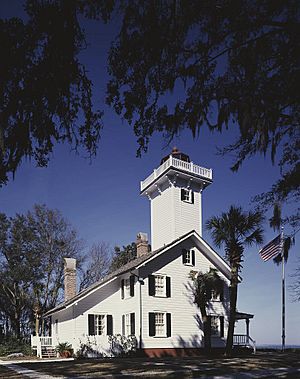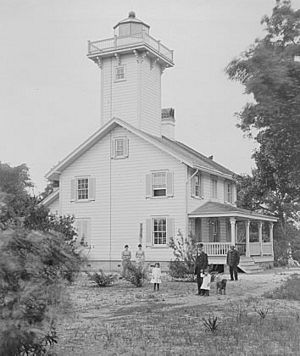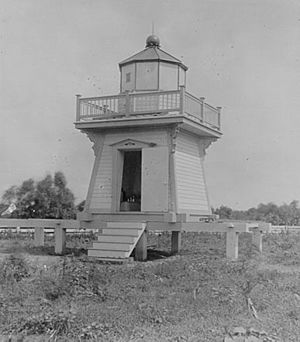Haig Point Range Lights facts for kids
 |
|
|
|
|
| Coordinates | 32°8′4.3″N 80°50′11.2″W / 32.134528°N 80.836444°W |
|---|---|
| Year first constructed | 1873 |
| Year first lit | 1873 1986 Private (Rear) |
| Deactivated | 1924 |
| Construction | Wood |
| Tower shape | Square tower on roof of house |
| Markings / pattern | White house and tower Red lantern |
| Height | 18 feet (5.5 m) (Front) 61 feet (19 m) (Rear) |
| Focal height | 17 feet (5.2 m) (Front) 70 feet (21 m) (Rear) |
| Original lens | Steamer lens (Front) 5th order Fresnel lens (Rear) |
| Current lens | Acrylic |
| Characteristic | Fl W 14s |
The Haig Point Range Lights were special lights that helped ships find their way. They were located on Daufuskie Island in Beaufort County, South Carolina. These lights were built in 1873. They worked as official guides for ships until about 1924.
One of the lights, called the Rear Range Light, has been fixed up. It is now a guest house for the Haig Point Club. It also still helps guide boats, but now it is a private light.
Calibogue Sound is a body of water between Daufuskie Island and Hilton Head Island. It connects the Intracoastal Waterway and the Harbour Town Marina to the Atlantic Ocean.
In 1871, the U.S. Congress decided to build two sets of range lights on Daufuskie Island. The other set of lights was called the Bloody Point Range Lights. They were on the south end of the island. Land was bought for the Haig Point lights in 1872. The Haig Point range lights first turned on in 1873. Most records say the lights stopped working around 1924.
Rear Range Light: A Guiding Beacon
The Rear Range Light was built by James H. Reed. It had a square tower on top of a two-story wooden house. This house was where the lighthouse keeper lived. The house and tower are painted white. The top part where the light shines, called the lantern, has a red roof.
The light first used a special lens called a Fresnel lens and a kerosene lamp. Later, an electric light was put in. Besides the house, there was also a small building for oil and a large tank for water. People worked at this light until about 1924.
In 1925, the house was sold. Over many years, different people owned it. The house became old and broken down. In 1984, a company bought the house. They started to fix it up. It became a guest house for the Haig Point Club. The oil house and water tank are still there today.
In 1986, the light in the Haig Point lighthouse was turned on again. It had been dark for about sixty years! This new light uses a clear plastic lens. It gets its power from solar cells and batteries. This bright white light helps guide boats today. It is a private light, not an official government one.
The Rear Range Light is an important part of the Daufuskie Island Historic District. This district is listed on the National Register of Historic Places. You can find more information and pictures from the South Carolina Department of Archives and History.
Front Range Light: A Moving Guide
The front range light was a wooden building with a lantern. It used a "steamer lens" to shine its light. This tower was about half a mile south of the Rear Range Light. It could be moved. This was important because the ship channel sometimes changed its path.
No one knows for sure what happened to the front light after the station closed. Some sources say it was destroyed.




